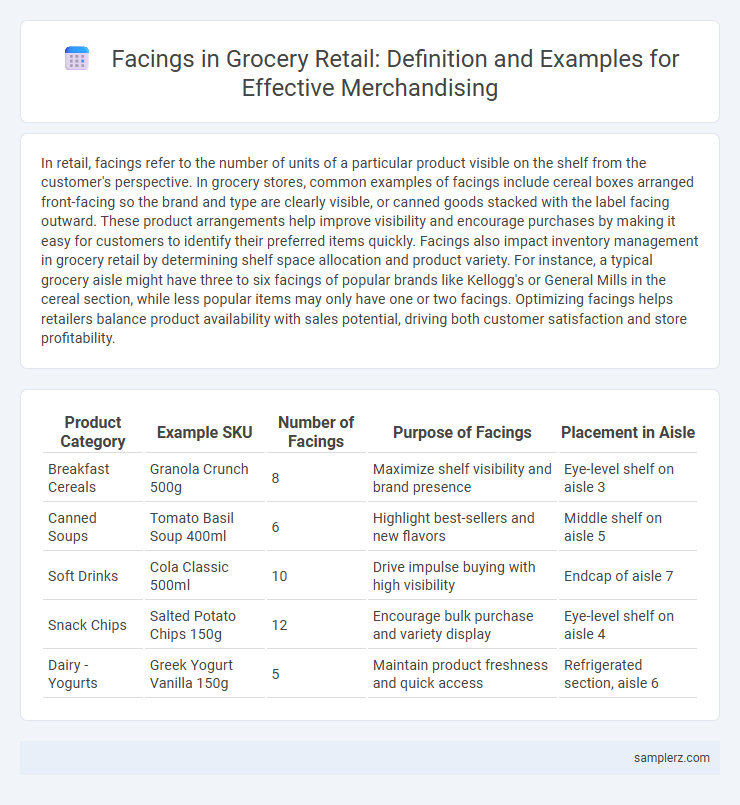In retail, facings refer to the number of units of a particular product visible on the shelf from the customer's perspective. In grocery stores, common examples of facings include cereal boxes arranged front-facing so the brand and type are clearly visible, or canned goods stacked with the label facing outward. These product arrangements help improve visibility and encourage purchases by making it easy for customers to identify their preferred items quickly. Facings also impact inventory management in grocery retail by determining shelf space allocation and product variety. For instance, a typical grocery aisle might have three to six facings of popular brands like Kellogg's or General Mills in the cereal section, while less popular items may only have one or two facings. Optimizing facings helps retailers balance product availability with sales potential, driving both customer satisfaction and store profitability.
Table of Comparison
| Product Category | Example SKU | Number of Facings | Purpose of Facings | Placement in Aisle |
|---|---|---|---|---|
| Breakfast Cereals | Granola Crunch 500g | 8 | Maximize shelf visibility and brand presence | Eye-level shelf on aisle 3 |
| Canned Soups | Tomato Basil Soup 400ml | 6 | Highlight best-sellers and new flavors | Middle shelf on aisle 5 |
| Soft Drinks | Cola Classic 500ml | 10 | Drive impulse buying with high visibility | Endcap of aisle 7 |
| Snack Chips | Salted Potato Chips 150g | 12 | Encourage bulk purchase and variety display | Eye-level shelf on aisle 4 |
| Dairy - Yogurts | Greek Yogurt Vanilla 150g | 5 | Maintain product freshness and quick access | Refrigerated section, aisle 6 |
Understanding Facings in Grocery Retail
Facings in grocery retail refer to the number of product units visible on the shelf, directly influencing consumer perception and purchase behavior. For example, a popular brand of cereal with four facings appears more prominent and accessible compared to a competitor with only one facing, increasing its chances of being chosen. Retailers optimize facings based on sales data and product turnover to enhance shelf presence and maximize revenue.
Common Types of Facings in Supermarkets
Common types of facings in supermarkets include open shelving, which allows easy access to products like cereals and canned goods, and pegboard displays ideal for hanging items such as snacks and small packaged goods. End caps are highly effective for promotional products and seasonal items, attracting customer attention at aisle endings. Refrigerated and freezer units provide facings for perishable goods like dairy, meats, and frozen foods, maintaining product visibility and freshness.
Shelf Facings: Maximizing Product Visibility
Shelf facings in grocery stores optimize product visibility by increasing the number of identical items displayed side by side, making it easier for customers to recognize and choose preferred brands. An effective shelf facing strategy involves allocating more facings to high-demand products like popular cereals or dairy items, enhancing sales opportunities and reinforcing brand presence. Utilizing precise shelf facings also reduces out-of-stock occurrences and improves inventory turnover in competitive retail environments.
Endcap Facings and Promotional Strategies
Endcap facings in grocery stores serve as high-visibility display units that maximize product exposure and drive impulse buys by positioning items at aisle intersections. Strategic use of endcap facings enhances promotional effectiveness by featuring seasonal products, limited-time offers, or high-margin goods to capture shopper attention and increase basket size. Retailers optimize endcap facings through data-driven selection and placement, leveraging insights on consumer behavior and purchase patterns to boost sales performance and ROI.
Refrigerated Product Facings in Grocery Stores
Refrigerated product facings in grocery stores typically include items such as dairy products, deli meats, pre-packaged salads, and beverages like juices and smoothies. Optimizing facings for refrigerated sections boosts visibility and accessibility, encouraging impulse purchases while maintaining product freshness. Strategic placement of best-selling brands and seasonal items further drives consumer engagement and increases sales revenue in refrigerated aisles.
Private Label Versus National Brand Facings
Private label facings in grocery stores typically occupy prominent shelf space to enhance brand visibility and customer preference, often positioned at eye-level to encourage trial and loyalty. National brand facings usually receive strategic placement near complementary products to leverage brand recognition and drive higher sales volumes. Optimizing the balance between private label and national brand facings can significantly impact retailer profitability and consumer purchasing behavior.
Seasonal Product Facings in Grocery Retail
Seasonal product facings in grocery retail strategically highlight items such as holiday-themed chocolates, summer beverages, and winter spices to attract customers and boost sales during specific periods. These facings maximize product visibility by positioning seasonal goods at eye level, near checkout counters, or in end-cap displays, driving impulse purchases. Data shows retailers experience a 15-25% increase in seasonal item turnover when facings are optimized for timely consumer demand and store traffic patterns.
Optimizing Facings for Impulse Buys
Optimizing facings in grocery stores by increasing shelf space for small, high-demand items like snack bars, gum, and single-serve beverages significantly boosts impulse buys. Strategic placement near checkout counters and end caps enhances product visibility, driving spontaneous purchases in high-traffic areas. Data shows that stores with optimized facings for impulse items see up to a 20% increase in sales for these categories.
Technology and Data in Managing Grocery Facings
Technology and data play a critical role in managing grocery facings by enabling real-time inventory tracking and automated shelf replenishment, improving product availability and reducing out-of-stock situations. Advanced analytics tools analyze customer buying patterns and optimize shelf layouts to maximize sales and enhance shopper experience. Retailers deploy planogram software integrated with smart sensors to ensure facings align with merchandising strategies and compliance standards, boosting operational efficiency and profitability.
Best Practices for Effective Facing Displays
Optimal grocery facing displays utilize consistent product alignment and clear labeling to enhance shopper navigation and boost sales. Employing color blocking and shelf zoning techniques increases product visibility and brand recognition. Regular shelf audits ensure facings are fully stocked and merchandise is front-facing, maintaining an inviting and organized appearance.

example of facings in grocery Infographic
 samplerz.com
samplerz.com